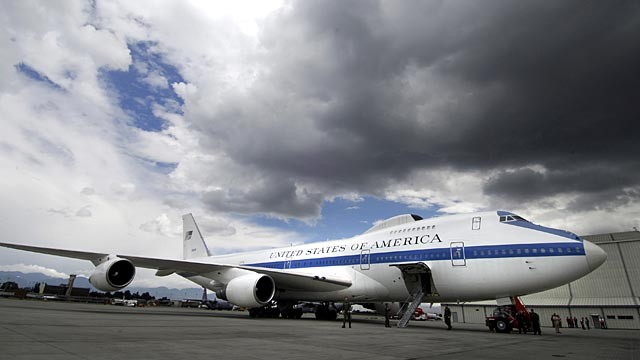Breaking News
|
Celebrity News
|
More ABC News Videos
The flight team for the E-4B, its military codename, sleeps nearby and is ready to scramble in five minutes. It was mobilized in the tumultuous hours after planes crashed into the World Trade Center, the Pentagon and southern Pennsylvania on 9/11.
"If the command centers that are on the ground in the United States have a failure of some sort, or attack, we immediately get airborne. We're on alert 24/7, 365," Captain W. Scott "Easy" Ryder, Commander, NAOC, told
ABC News' Diane Sawyer as she traveled to
Afghanistan with
Secretary of Defense Robert Gates on the apocalypse-proof plane. "Constantly there's at least one alert airplane waiting to get airborne."
Watch "World News" tonight on ABC to learn more about the Air Force's last line of defense.
All E-4B aircraft are assigned to the 55th Wing, Offutt Air Force Base, Neb. The modified 747s can travel at speeds up to 620 miles per hour, 40 miles per hour faster than their commercial counterparts.
The $223 million aircraft is outfitted with an electromagnetic pulse shield to protect its 165,000 pounds of advanced electronics. Thermo-radiation shields also protect the plane in the event of a nuclear strike.
A highly-trained security team travels with the plane.
"The first people off of the airplane are these guys, they'll position themselves appropriately around the airplane," Ryder said to ABC News. "The secretary also has his own small security staff that does similar things. So these guys are predominately designed to protect our airplane, and the secretary's staff protects him, as an individual."
Even though it carries VIPs, their staff and security personnel, the plane is highly fuel efficient. The plane can stay in-flight for days without refueling, a necessity if circumstances demanded the plane's use by the nation's top officials.
A precision tech team mans the sensitive electronic technology found on the plan. There is so much powerful electrical equipment onboard a specially upgraded air-conditioning system is necessary to keep it cool and functional.
"Give us the phone number of anybody, anytime, anyplace, anywhere on earth, we can get a hold of them," Master Sgt. Joe Stuart, US Air Force, told Diane Sawyer.
It can even communicate with submerged submarines by dropping a five-mile-long cable out the back of the plane. "[We] drop is down and [it] transmits coded message traffic to US submarines," Ryder told ABC News.
Although the extreme amount of survival technology on the plane more than makes up for it, the plane lacks the amenities found in bases on the ground.
"It's like being Fedexed," Gates told Sawyer. "It's fairly Spartan, with no windows or anything."
Even the Secretary of Defense only gets a tiny bathroom with a sink, but no shower. A small trade-off for being able to board this plane as the rest of us dive for cover in a worst-case scenario.

Primary Function: Airborne operations center

Contractor: Boeing Aerospace Co.

Power Plant: Four General Electric CF6-50E2 turbofan engines

Thrust: 52,500 pounds each engine

Wingspan: 195 feet, 8 inches (59.7 meters)

Length: 231 feet, 4 inches (70.5 meters)

Height: 63 feet, 5 inches (19.3 meters)

Weight: 410,000 pounds (185,973 kilograms)

Maximum Takeoff Weight: 800,000 pounds (360,000 kilograms)

Fuel Capacity: 410,000 (185,973 kilograms)

Payload: communications gear permanently installed on aircraft

Speed: 602 miles per hour (523 knots)

Range: 6,200 nautical miles

Ceiling: Above 30,000 feet (9,091 meters)

Crew: Up to 112 (flight crew and mission crew)

Unit Cost: $223.2 million (fiscal 98 constant dollars)

Initial operating capability: January 1980

Inventory: Active force, 4
ABC News' James Wang contributed to this article.









































 Primary Function: Airborne operations center
Primary Function: Airborne operations center














